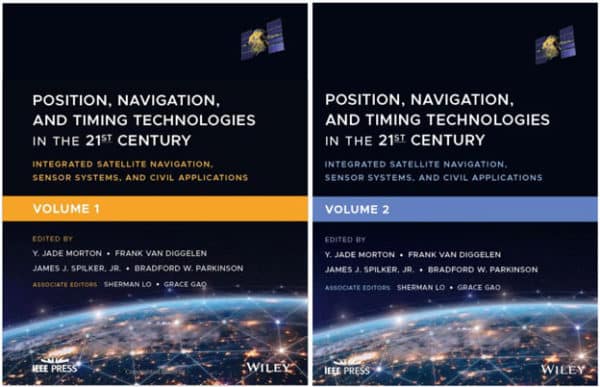Position, Navigation, and Timing Technologies in the 21st Century: Integrated Satellite Navigation, Sensor Systems, and Civil Applications, Set, Volumes 1 and 2
Y. Jade Morton (Editor), Frank van Diggelen (Editor), James J. Spilker Jr. (Editor), Bradford W. Parkinson (Editor), Sherman Lo (Associate Editor), Grace Gao (Associate Editor)
This text covers the latest developments in PNT technologies, including integrated satellite navigation, sensor systems, and civil applications. The two-volume work consists of sixty-four chapters are divided into six parts, and provides comprehensive coverage of the state-of-the-art in satellite-based position, navigation, and timing (PNT) technologies and civilian applications. It also examines alternative navigation technologies based on other signals-of-opportunity and sensors and offers a comprehensive treatment on integrated PNT systems for consumer and commercial applications.
Volume 1 of Position, Navigation, and Timing Technologies in the 21st Century: Integrated Satellite Navigation, Sensor Systems, and Civil Applications contains three parts and focuses on the satellite navigation systems, technologies, and engineering and scientific applications. It starts with a historical perspective of GPS development and other related PNT development. Current global and regional navigation satellite systems (GNSS and RNSS), their inter-operability, signal quality monitoring, satellite orbit and time synchronization, and ground- and satellite-based augmentation systems are examined. Recent progresses in satellite navigation receiver technologies and challenges for operations in multipath-rich urban environment, in handling spoofing and interference, and in ensuring PNT integrity are addressed. A section on satellite navigation for engineering and scientific applications finishes off the volume.
Volume 2 of Position, Navigation, and Timing Technologies in the 21st Century: Integrated Satellite Navigation, Sensor Systems, and Civil Applications consists of three parts and addresses PNT using alternative signals and sensors and integrated PNT technologies for consumer and commercial applications. It looks at PNT using various radio signals-of-opportunity, atomic clock, optical, laser, magnetic field, celestial, MEMS and inertial sensors, as well as the concept of navigation from Low-Earth Orbiting (LEO) satellites. GNSS-INS integration, neuroscience of navigation, and animal navigation are also covered. The volume finishes off with a collection of work on contemporary PNT applications such as survey and mobile mapping, precision agriculture, wearable systems, automated driving, train control, commercial unmanned aircraft systems, aviation, and navigation in the unique Arctic environment.
This reference —
- Serves as a complete reference and handbook for professionals and students interested in the broad range of PNT subjects
- Includes chapters that focus on the latest developments in GNSS and other navigation sensors, techniques, and applications
- Illustrates interconnecting relationships between various types of technologies in order to assure more protected, tough, and accurate PNT
- Position, Navigation, and Timing Technologies in the 21st Century: Integrated Satellite Navigation, Sensor Systems, and Civil Applications will appeal to all industry professionals, researchers, and academics involved with the science, engineering, and applications of position, navigation, and timing technologies.
About the Editors
Y. Jade Morton, Ph.D., is a Professor at Ann and H. J. Smead Aerospace Engineering Sciences Department, University of Colorado at Boulder. Her research interests lie at the intersection of satellite navigation and remote sensing of the space environment, atmosphere, and Earth surface. She has led numerous research projects sponsored by AFOSR, AFRL, DARPA, NASA, NSF, ONR, and private industries. Dr. Morton is the President of the Institute of Navigation (ION), a fellow of IEEE, ION, and the Royal Institute of Navigation (RIN, UK).
Frank Van Diggelen, Ph.D., is a Principal Engineer at Google, where he leads the Android Core-Location Team. He also teaches at Stanford University. He is the inventor of coarse-time GNSS navigation, co-inventor of Long Term Orbits for A-GNSS, and the author of A-GPS the first textbook on Assisted GNSS. He is Executive Vice President of the Institute of Navigation (ION) and a Fellow of the ION and the Royal Institute of Navigation (UK).
James J. Spilker, Jr., Ph.D., was a Consulting Professor in the Aeronautics and Astronautics Department at Stanford University. Dr. Spilker was an elected member of the National Academy of Engineering, a Life Fellow of the IEEE, and a Fellow of the Institute of Navigation (ION). As one of the originators of GPS, James Spilker shared the Goddard Memorial Trophy and the Queen Elizabeth Prize for Engineering.
Bradford W. Parkinson, Ph.D., is an Edward C. Wells Professor of Aeronautics and Astronautics Emeritus at Stanford University. Dr. Parkinson was the Chief Architect for GPS, led the original advocacy and development for the system, and served as the first Director of the GPS Joint Program Office. He has been the CEO of two companies and serves on many boards. Among his many awards are the IEEE Medal of Honor, the Draper Prize of the National Academy of Engineering, and the Queen Elizabeth Prize for Engineering.
Publisher: Wiley-IEEE Press
Copyright: 2021
Pages: 2064
ISBN-ISBN: 978-1-119-45834-0
Print on Demand (Can take 2 to 4 weeks before delivery)
